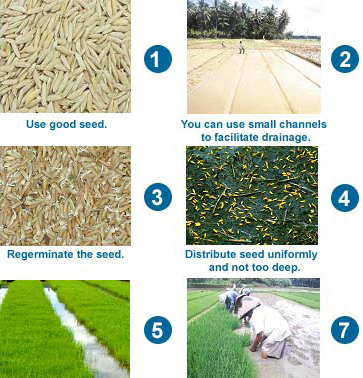Reduced area wet-bed nursery
What is a reduced area wet-bed nursery?
 A reduced area wet-bed nursery is similar to traditional nurseries except that it uses just 1% of land compared to traditional nurseries that require about 5−10% of the land to be planted. Seed is sown at a higher density.
A reduced area wet-bed nursery is similar to traditional nurseries except that it uses just 1% of land compared to traditional nurseries that require about 5−10% of the land to be planted. Seed is sown at a higher density.
Why use a reduced area wet-bed nursery?
The reduced area wet-bed nursery produces robust, healthy, and vigorous seedlings in 15−20 days. When combined with the use of good quality seed, the resulting seedlings require less replanting, have fewer problems with weeds, less prone to insects and diseases, and leads to higher yields.
Note: While stressed seedlings can actually grow out of stress with little effect on yield potential, they are less competitive during early crop growth.
How to establish a reduced wet-bed nursery?
- Seed required: To plant 1 ha (with 2 seedlings per hill at 20 cm x 20 cm spacing), use 18−25kg good quality seed (with > 80% germination and establishment). Note: Good seed results in lower seed rates, more uniform germination, vigorous seedlings, less replanting, fewer weeds, and 5−20% higher yield.
- Preparing nursery area: Prepare 100 m2 of nursery for each 1 ha to be planted. Apply 100kg of well-decomposed organic manure or the equivalent of 20 kg N/ha (i.e., around 1.5 kg of 15-15-15 NPK fertilizer or diammonium phosphate (DAP) per 100 m2). Plow, puddle and level the field well. After the final pass, allow 1−2 days before sowing for the mud to settle and for any water on the soil surface to become clear. Note: If the drainage is poor in the nursery area, then make 1 m wide beds about 4−5 cm high. The narrow space in between beds is for walking and drainage.
- Pre-germinating seeds: Prepare seed at the same time as the final land preparation for the nursery: Soak the seed for 24 h (some varieties may need longer to bud). Drain and incubate (cover and keep moist) for 24 h. At this time, the seeds sprout (bud) and the first seed root grows to 2−3 mm long.
- Sowing: Sow the pre-germinated seed uniformly on the prepared seedbed. (Approximately 1 seed/cm2)
- Irrigating the seedbed: Irrigate the seedbed 2−3 days after sowing or when the soil begins to crack. As the seedlings grow, maintain a water level of 2 cm above the soil surface until the seedlings are removed.
- Fertilizer topdressing (optional): If the temperature and water are adequate, but the seedlings show yellowing (Nitrogen deficiency), apply the equivalent of 10−20 kg N/ha (i.e., 0.20−0.40 kg of urea or 0.75 to 1.5 kg DAP) at 10−12 days after seeding (DAS) per 100 m2.
- Pulling the seedlings: Seedlings will be ready for transplanting at 15−20 DAS. Flood the nursery and carefully pull the seedlings to reduce damage to roots. Bundle the seedlings for transport to main field.
Limitations
The system is best suited for irrigated areas. If transplanting is delayed, seedlings can be damaged when separated for planting.







